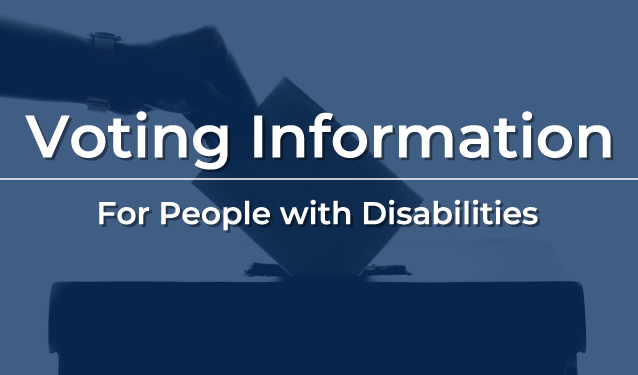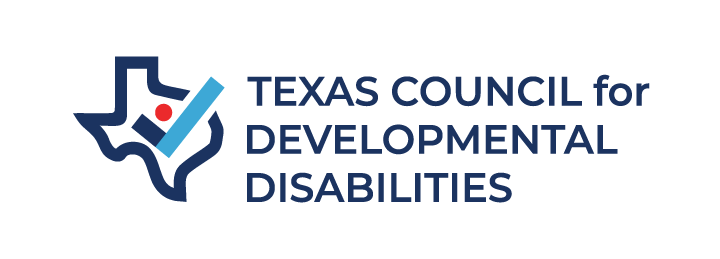

Election Day is here! On Tuesday, Nov. 5, people across the country will head to the polls to vote. Casting your vote is a powerful way to share your priorities for the future. The Texas Council for Developmental Disabilities (TCDD) has gathered resources to help people with disabilities access voting information and support.
Voting by Mail
If you’re voting by mail, Election Day is the deadline for your local election office to receive your ballot. However, if your ballot is postmarked by 7 p.m. on Election Day (Tuesday, Nov. 5), your vote will count as long as your local office receives your ballot by 5 p.m. the following day (Wednesday, Nov. 6).
The Texas Secretary of State website provides instructions on how to fill out, print, and mail your ballot. The website also includes information on how to track your ballot once you have mailed it.
Find Your Polling Location
To vote in person, you will first find your polling location. If your county is part of the Countywide Polling Place Program (CWPP), you can vote at any location in the county where you’re registered to vote. If your county does not participate in the CWPP, you can only vote in your voting precinct.
Find your polling location by using the My Voter Portal website. After entering your information under the “Am I Registered” section, click “11/05/2024–2024 NOVEMBER 5TH GENERAL ELECTION” to find a list of polling places in your county. You can find detailed instructions, including photos, on how to find your polling location on the TCDD website.
Many newspapers publish Election Day polling locations. You can also contact your county elections office for polling location information. Election Day voting hours are 7 a.m. to 7 p.m. at all polling places statewide. If you are in line by 7 p.m., you can cast your ballot.
Plan Transportation
Plan your transportation to the polls ahead of time. Disability Rights Texas (DRTx) has gathered information about different transportation options across Texas. The Find a Ride Guide includes information on transportation providers, phone numbers, websites, fares, accessibility options, and more. The guide is a spreadsheet that you can download and open using Microsoft Excel or Google Sheets.
If you need help accessing the Find a Ride Guide, fill out this form. You can also get help finding a ride by calling the DRTx Voting Rights Hotline at 1-888-796-VOTE (8683) or by emailing vote@DRTX.org.
What to Expect at the Polls
When you arrive at the polls, there will likely be a line of people waiting to vote. Senate Bill (SB) 477, passed in 2023, allows voters with mobility-related disabilities to cast their ballots without waiting in long lines.
SB 477 also requires each polling location to designate a parking space for curbside voting. This space is in addition to spaces already designated for people with disabilities. A telephone number or intercom system should be posted in the designated curbside space so you can contact an election official for assistance.
Voters with disabilities can receive assistance when casting ballots. If you need assistance to vote at a polling location, here are some things to know.
- When you arrive at a polling location, tell a poll worker that you are a voter who needs help to vote. You do not have to provide proof of your disability.
- If you are unable to enter a polling location, you can ask a poll worker to bring your ballot to the entrance of the polling location or to a vehicle parked at the curbside of the polling location. After you complete your ballot, the poll worker will collect it and put it in the ballot box for you. You can also ask to have another person of your choice bring you your ballot, collect it, and put it in the ballot box.
- If you go by yourself to a polling location, you may want to call ahead so poll workers will be ready to assist you when you arrive.
In collaboration with partners in the disability community, TCDD developed the video below to share essential voting information for people with disabilities and poll workers. The video covers voting with accommodations and how poll workers can support voters with disabilities. It also shows a general overview of what to expect at the polls when voting.
Who Can Help You Vote
You can receive help to vote from: (A) any person you choose who is not a poll worker, (B) two poll workers on Election Day, or (C) one poll worker during early voting.
You cannot receive help from: (A) your employer, (B) an agent of your employer, or (C) an officer or agent of your union if you are a member of one.
A person who helps you must:
- fill out a form that states the person’s name, address, and relationship to you (for example, the person could be a friend or relative);
- sign an oath that you are eligible to receive assistance to vote and that they will not influence your vote;
- read the entire ballot to you unless you ask to have only parts of the ballot read to you;
- mark your ballot exactly as you direct them (only if you need assistance marking your ballot); and
- keep your voting choices secret from anyone else.
If you choose to get help from a poll worker, then poll watchers and election inspectors are allowed to watch you vote, and poll watchers can inspect your ballot to ensure it was marked as you directed. However, if you are helped by someone you chose who is not a poll worker, no one else can watch you vote.
If a person provides transportation to a polling location for seven or more people who are not relatives, that person must sign a form with their name and address. They must also indicate if they are also helping a voter cast a ballot
Additional Resources
Want to vote, but need more information? VoteTexas.gov has resources for voters with disabilities. This includes additional information about voter registration, accessible voting systems, and polling places.
If you have trouble voting, call the DRTx hotline at 1-888-796-VOTE (8683) or email vote@DRTX.org. DRTx staff trains people with disabilities on voting rights, surveys polling places for accessibility, works with election officials, and responds to legislative inquiries.
